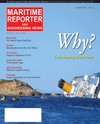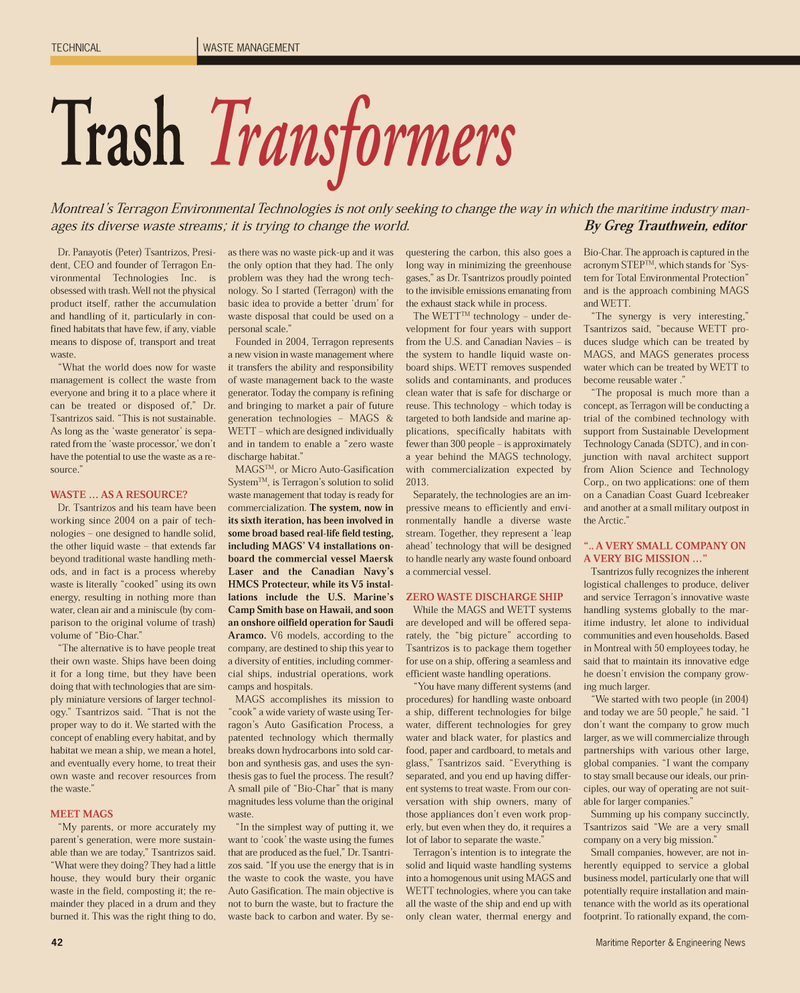
Page 42: of Maritime Reporter Magazine (February 2012)
Cruise Shipping Annual
Read this page in Pdf, Flash or Html5 edition of February 2012 Maritime Reporter Magazine
TECHNICALWASTE MANAGEMENT42Maritime Reporter & Engineering News Dr. Panayotis (Peter) Tsantrizos, Presi- dent, CEO and founder of Terragon En- vironmental Technologies Inc. is obsessed with trash. Well not the physical product itself, rather the accumulationand handling of it, particularly in con-fined habitats that have few, if any, viable means to dispose of, transport and treatwaste. ?What the world does now for waste management is collect the waste from everyone and bring it to a place where it can be treated or disposed of,? Dr. Tsantrizos said. ?This is not sustainable.As long as the ?waste generator? is sepa- rated from the ?waste processor,? we don?t have the potential to use the waste as a re- source.? WASTE ? AS A RESOURCE? Dr. Tsantrizos and his team have been working since 2004 on a pair of tech-nologies ? one designed to handle solid,the other liquid waste ? that extends far beyond traditional waste handling meth- ods, and in fact is a process whereby waste is literally ?cooked? using its own energy, resulting in nothing more than water, clean air and a miniscule (by com- parison to the original volume of trash) volume of ?Bio-Char.? ?The alternative is to have people treat their own waste. Ships have been doing it for a long time, but they have been doing that with technologies that are sim-ply miniature versions of larger technol- ogy.? Tsantrizos said. ?That is not the proper way to do it. We started with the concept of enabling every habitat, and by habitat we mean a ship, we mean a hotel,and eventually every home, to treat their own waste and recover resources from the waste.? MEET MAGS ?My parents, or more accurately myparent?s generation, were more sustain-able than we are today,? Tsantrizos said. ?What were they doing? They had a little house, they would bury their organic waste in the field, composting it; the re- mainder they placed in a drum and they burned it. This was the right thing to do, as there was no waste pick-up and it was the only option that they had. The only problem was they had the wrong tech- nology. So I started (Terragon) with the basic idea to provide a better ?drum? for waste disposal that could be used on a personal scale.? Founded in 2004, Terragon represents a new vision in waste management where it transfers the ability and responsibilityof waste management back to the waste generator. Today the company is refining and bringing to market a pair of future generation technologies ? MAGS & WETT ? which are designed individually and in tandem to enable a ?zero waste discharge habitat.? MAGS TM, or Micro Auto-Gasification SystemTM, is Terragon?s solution to solid waste management that today is ready for commercialization. The system, now in its sixth iteration, has been involved in some broad based real-life field testing, including MAGS? V4 installations on- board the commercial vessel Maersk Laser and the Canadian Navy?s HMCS Protecteur, while its V5 instal- lations include the U.S. Marine?s Camp Smith base on Hawaii, and soonan onshore oilfield operation for Saudi Aramco. V6 models, according to thecompany, are destined to ship this year to a diversity of entities, including commer- cial ships, industrial operations, work camps and hospitals.MAGS accomplishes its mission to ?cook? a wide variety of waste using Ter- ragon?s Auto Gasification Process, a patented technology which thermallybreaks down hydrocarbons into sold car- bon and synthesis gas, and uses the syn- thesis gas to fuel the process. The result? A small pile of ?Bio-Char? that is many magnitudes less volume than the original waste. ?In the simplest way of putting it, we want to ?cook? the waste using the fumes that are produced as the fuel,? Dr. Tsantri- zos said. ?If you use the energy that is in the waste to cook the waste, you have Auto Gasification. The main objective is not to burn the waste, but to fracture the waste back to carbon and water. By se- questering the carbon, this also goes along way in minimizing the greenhouse gases,? as Dr. Tsantrizos proudly pointed to the invisible emissions emanating from the exhaust stack while in process. The WETTTMtechnology ? under de-velopment for four years with support from the U.S. and Canadian Navies ? is the system to handle liquid waste on- board ships. WETT removes suspended solids and contaminants, and producesclean water that is safe for discharge or reuse. This technology ? which today is targeted to both landside and marine ap- plications, specifically habitats with fewer than 300 people ? is approximately a year behind the MAGS technology, with commercialization expected by 2013.Separately, the technologies are an im- pressive means to efficiently and envi- ronmentally handle a diverse waste stream. Together, they represent a ?leap ahead? technology that will be designed to handle nearly any waste found onboard a commercial vessel. ZERO WASTE DISCHARGE SHIP While the MAGS and WETT systems are developed and will be offered sepa- rately, the ?big picture? according to Tsantrizos is to package them togetherfor use on a ship, offering a seamless and efficient waste handling operations. ?You have many different systems (and procedures) for handling waste onboard a ship, different technologies for bilge water, different technologies for grey water and black water, for plastics and food, paper and cardboard, to metals andglass,? Tsantrizos said. ?Everything is separated, and you end up having differ- ent systems to treat waste. From our con- versation with ship owners, many of those appliances don?t even work prop- erly, but even when they do, it requires a lot of labor to separate the waste.? Terragon?s intention is to integrate the solid and liquid waste handling systems into a homogenous unit using MAGS and WETT technologies, where you can take all the waste of the ship and end up with only clean water, thermal energy and Bio-Char. The approach is captured in the acronym STEP TM, which stands for ?Sys-tem for Total Environmental Protection? and is the approach combining MAGS and WETT. ?The synergy is very interesting,? Tsantrizos said, ?because WETT pro- duces sludge which can be treated byMAGS, and MAGS generates process water which can be treated by WETT to become reusable water .? ?The proposal is much more than aconcept, as Terragon will be conducting a trial of the combined technology withsupport from Sustainable Development Technology Canada (SDTC), and in con- junction with naval architect support from Alion Science and Technology Corp., on two applications: one of them on a Canadian Coast Guard Icebreaker and another at a small military outpost inthe Arctic.? ?.. A VERY SMALL COMPANY ON A VERY BIG MISSION ?? Tsantrizos fully recognizes the inherentlogistical challenges to produce, deliver and service Terragon?s innovative waste handling systems globally to the mar- itime industry, let alone to individual communities and even households. Based in Montreal with 50 employees today, he said that to maintain its innovative edge he doesn?t envision the company grow- ing much larger. ?We started with two people (in 2004) and today we are 50 people,? he said. ?I don?t want the company to grow much larger, as we will commercialize through partnerships with various other large, global companies. ?I want the company to stay small because our ideals, our prin-ciples, our way of operating are not suit- able for larger companies.? Summing up his company succinctly, Tsantrizos said ?We are a very small company on a very big mission.? Small companies, however, are not in- herently equipped to service a globalbusiness model, particularly one that will potentially require installation and main-tenance with the world as its operational footprint. To rationally expand, the com- Trash Transformers Montreal?s Terragon Environmental Technologies is not only seeking to change the way in which the maritime industry man- ages its diverse waste streams; it is trying to change the world. By Greg Trauthwein, editor MR Feb.12 # 5 (42-48):MR Template 2/7/2012 10:04 AM Page 42

 41
41

 43
43
